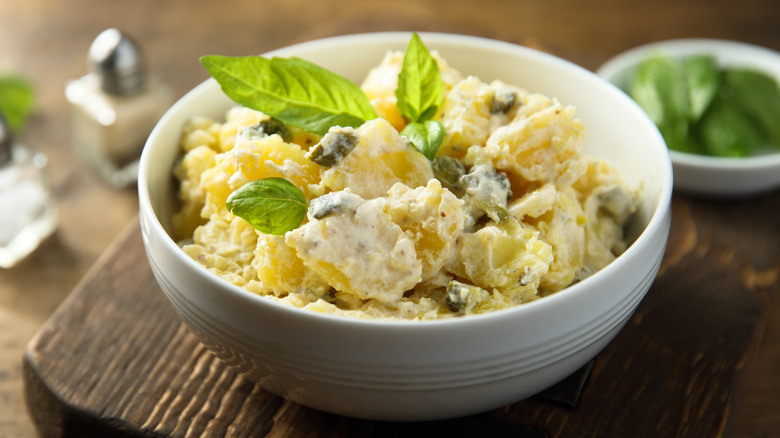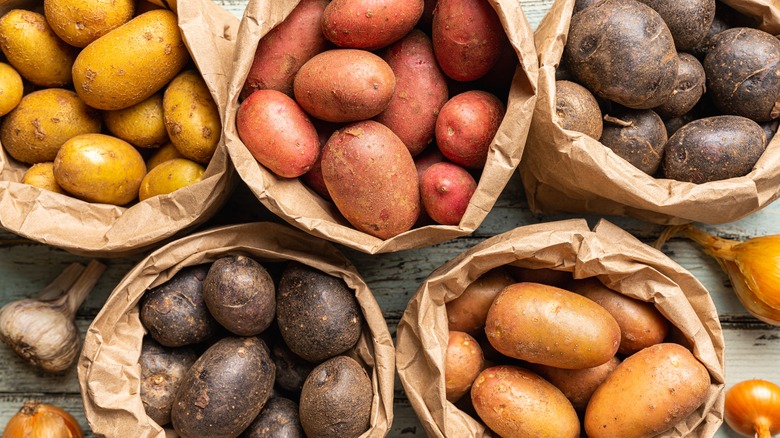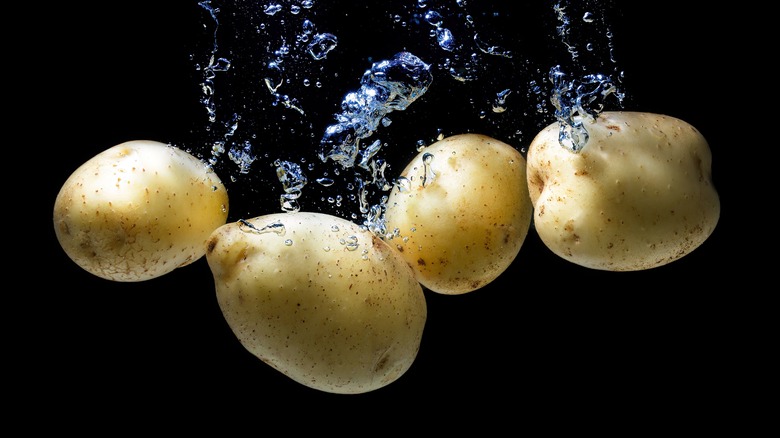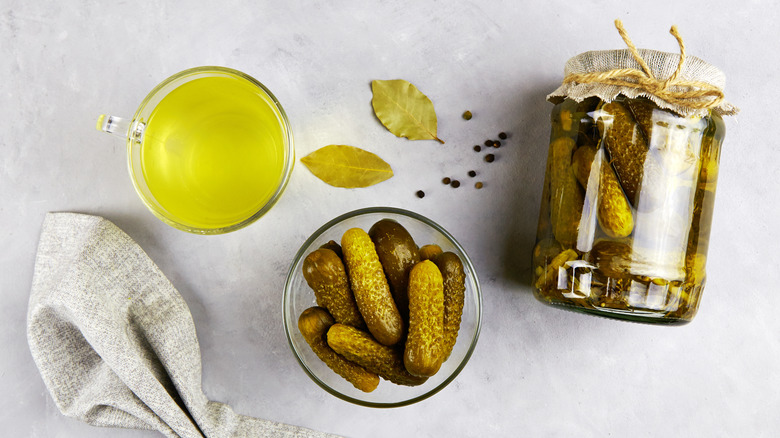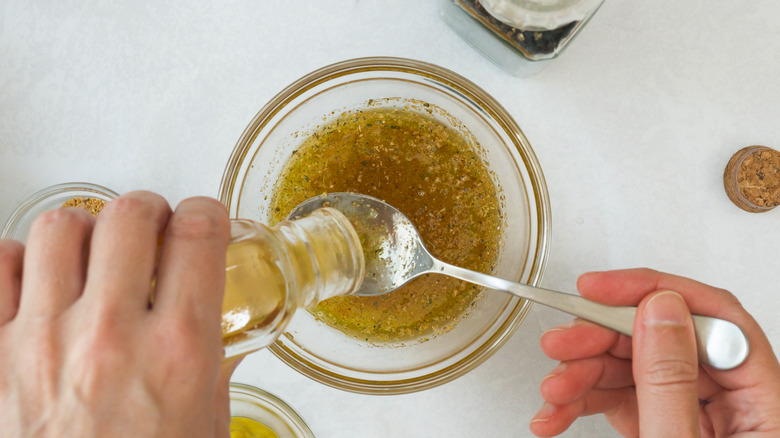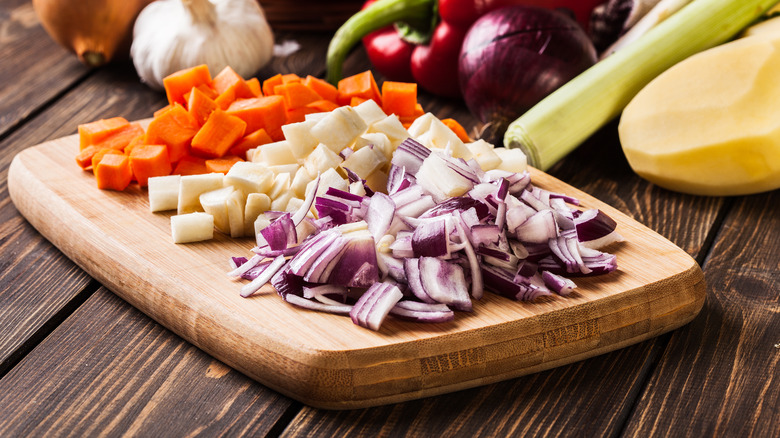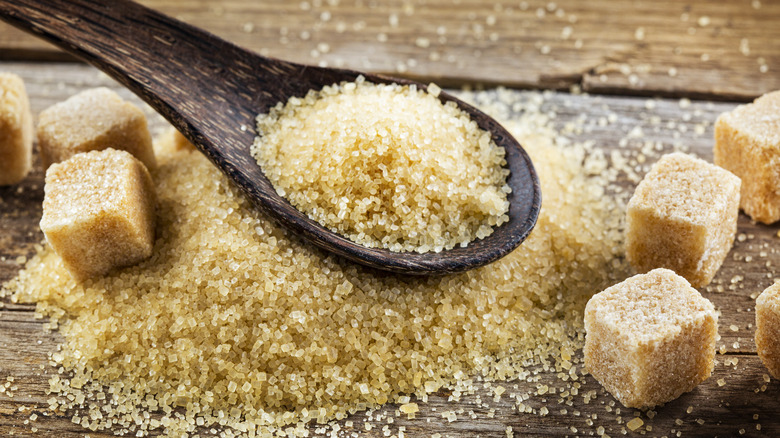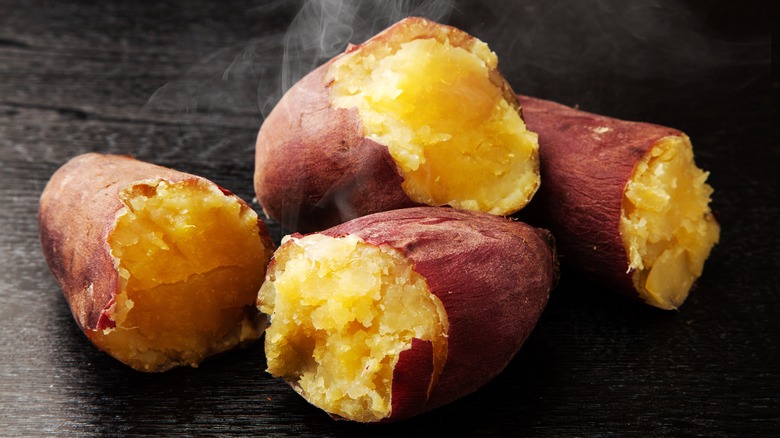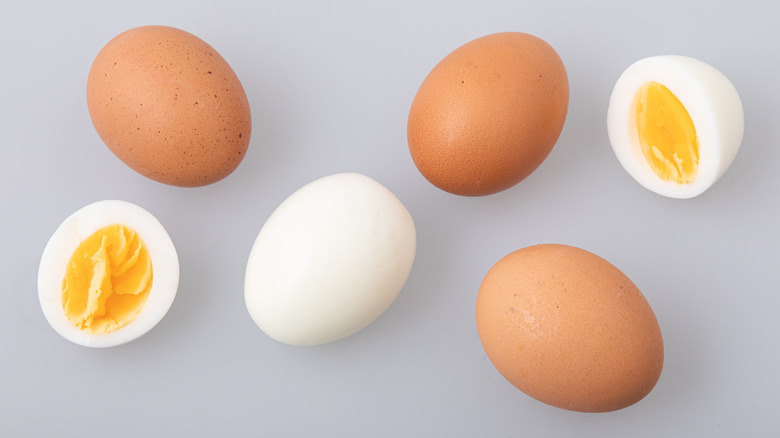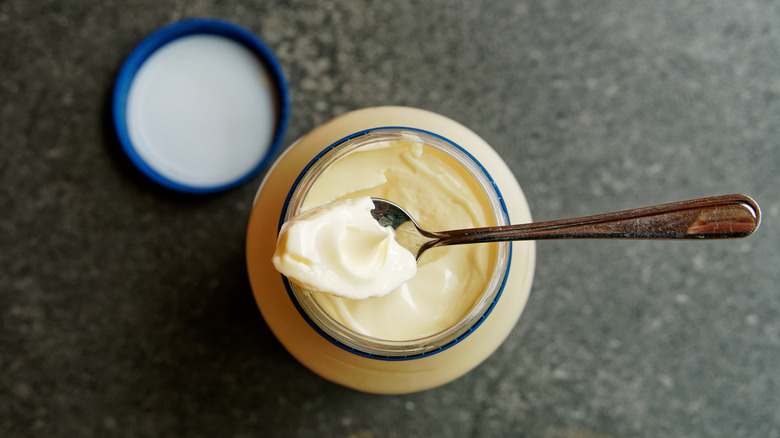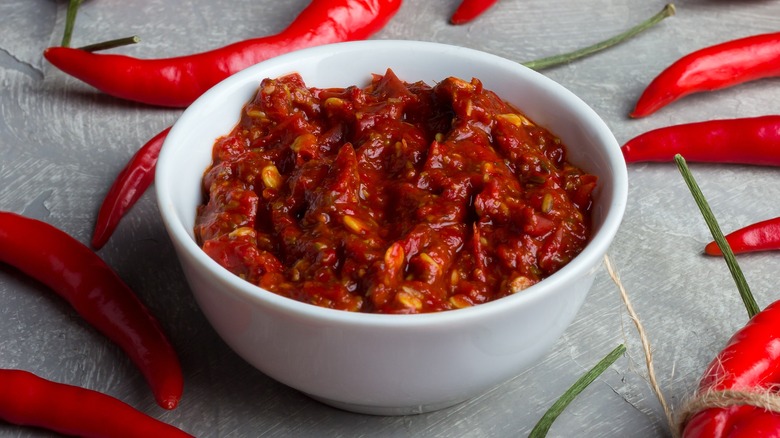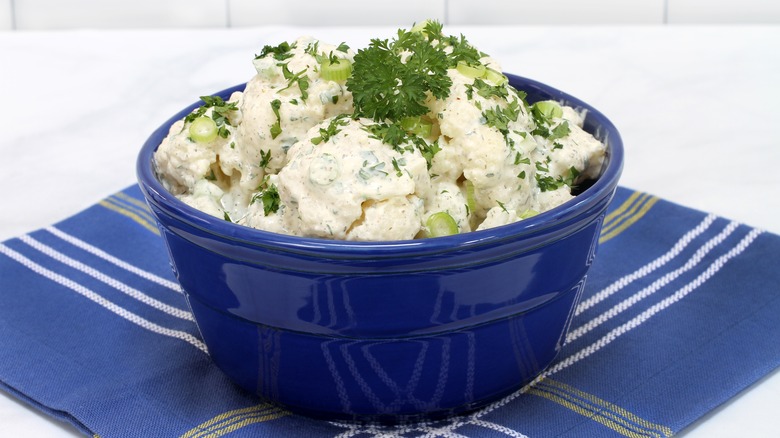12 Tips You Need To Make The Absolute Best Potato Salad
Potato salad is a delightful, staple comfort food across many different countries and cultures. In the United States, the cream and carb combination can immediately transport you to your local deli, backyard BBQ, or even the comfort of your grandma's house. Regardless of the location, we're willing to bet that potato salad holds a sentimental spot in your culinary heart.
That said, the humble side dish can sometimes be depicted as an afterthought — slapped down onto a tray by the school lunch lady or pushed to the edges of a potluck table. Yes, a menu item like potato salad may never replace the filet mignon, but that doesn't mean it can't shine. In fact, with such a luscious, neutral flavor like potato, there is so much you can do to spice it up.
We've curated a list of some of the best tips and tricks to make sure your potato salad is a hit. No more hiding the salad you love because it came out mushy or bland. From must-know preparation techniques to flavor combinations from around the world, you'll be more than covered. It's time to bring your potato salad to the forefront of any occasion.
1. Choose the right kind of potato
What type of potato you use might not seem like a big deal, but certain varieties can alter your salad texture and overall turnout. You want to stay away from starchy potatoes, if possible. These varieties can be identified by their thicker skins and drier, more crumbly texture when eaten. During the cooking process, they absorb a lot of water or oil, making them best reserved for frying or mashing. On the other hand, waxy potato varieties lend themselves better to dishes like soups, or, of course, the star of our show — potato salad. Waxy potatoes can be identified by their thinner skins, smaller size, creamier texture, and slightly firmer bite when eaten. Since they naturally have a lot of moisture, they won't absorb too much water. This makes waxy potato varieties less likely to become gummy and more likely to maintain their shape during boiling.
So, when choosing the best potatoes for your potato salad, waxy is the way to go. There are a handful of potato varieties that lean more waxy as opposed to starchy that you can choose from. Yukon Golds, red bliss, Vitelottes, French fingerling, Russian banana, and Red Thumbs are all great options. When in doubt, think small potatoes!
2. Aim for the perfect potato texture
The last thing you want to serve up is a dish halfway between potato salad and mashed potatoes. In order to ensure the potatoes boil evenly throughout, you want to start the potatoes off in cold water and then let them come up to a boil. It's important to remember that potatoes need their sweet time. There's a reason we've come up with the term "couch potato" — it's okay to let them sit there for a bit.
You'll want to continue cooking them at a medium-low temperature for 15 to 30 minutes (depending on the type and size of the potato). Around the halfway point, add a dash of vinegar. Don't worry too much about the type of vinegar — it's more about utilizing the acidic properties of vinegar in general. The acid prolongs the breakdown process of the potatoes which helps them maintain their shape and ultimately improves their texture. For potato salad purposes, the hint of tanginess leftover from the vinegar will only provide an added depth of flavor. If you're not a vinegar fan, you have nothing to worry about. You can always decide to rinse the potatoes off once they're cooked.
To test if your potatoes are done, you can poke them with a toothpick, skewer, or fork (pick your poison). If you feel too much resistance the spuds are likely underdone, while too little would equate to overdone. The sweet spot you're aiming for is somewhere in the middle.
3. Boil your potatoes in pickle juice
Yes, you read that correctly — pickle juice. Pickle juice seems to be either deeply loved or fiercely hated by those who try it. Regardless of your stance, this flavorful brine is sure to add a unique punch to your potato salad. All you have to do is add some of the juice from a pickle jar (one that may already be in your fridge) into your pot of water. Next, you can place your potatoes in, bring them up to a boil, and then sit back and let the magic happen. As they boil they'll soak up all the pickle juice ingredients like vinegar, salt, dill, garlic, and whichever additional spices are included. The result is a surprisingly tangy yet not overwhelming pop to your potato salad.
There is a lot to love when it comes to this recipe tweak, but if you're still on the anti-pickle juice train, you have other options. You can consider the previous vinegar tip, or just add a bit of salt to your water when boiling. It's important to keep in mind that flavor is developed during this part of the potato salad process as well, so there's no reason to skip it.
4. Cover your potatoes after draining
This tip is probably the most overlooked, yet extremely valuable before forming the rest of your potato salad. Once you've drained your potatoes you would be remiss to just let them sit out. Instead, let your potatoes steam for just a bit. This allows the potatoes to become even more tender in the middle and gives you a softer, more velvety spud.
Luckily, this extra step doesn't need to involve much work on your part. There's no reason to get your steamer pot or basket out at this point. All you really need is a towel to drape over your potatoes once they're drained. This is the extra step Ina Garten, aka the Barefoot Contessa, takes. Ina has shared that after draining her potatoes in a colander she places a towel over them, letting them steam underneath for about 10 minutes. This way, the texture becomes even more luxurious. This little adjustment goes a long way in getting your potato salad just right.
5. Dress your potatoes at the right time
There is a subtle art to dressing potatoes. Too soon or too late can skew your intended results and ruin the whole preparation process. As a rule of thumb, if you're making mayonnaise, yogurt, or any other cream-based potato salad, make sure you let your potatoes cool down first. You want to dress them while they're cool so they don't become too oily or runny. If, on the other hand, you prefer a mustard or vinegar-based potato salad, dress the potatoes while they're warm so they absorb the ingredients better. This will help bump up the flavor with every bite. If you're in need of some recipe inspiration when it comes to potato dressing, here's a classic mayonnaise-based potato salad dish dressed while cold, as well as a mustard and vinegar-based potato salad dish dressed while warm.
You also want to make sure that whatever other ingredients you add to your potato salad are mixed together well before combining and tossing the two. A varied dressing with even flavors across the board is highly desirable when it comes to potato salad.
6. Get your crunch on
What's a salad without a good crunch? Adding some bite to your potato salad will give it a more varied texture and layered flavor profile. Consider finely chopping vegetables such as pickles, celery, red onions, and bell peppers along with herbs like dill to complete your potato salad. You can also experiment with other types of raw or pickled vegetables. For example, radishes and olives make great additions. That's the wonderful part about potato salad. The neutral flavor of potato leaves you with a lot of room to experiment with your flavors and ingredients.
When it comes to crunch, you can even decide to flip the script and focus on the potatoes themselves instead of the vegetables. One idea is to also roast your potatoes as opposed to just boiling them. There are a number of tricks for getting your roasted potatoes extra crispy, but one, in particular, stands out — parboiling them in baking soda. Parboiling means partially cooking them so that the outer half is soft but the middle is still hard. By parboiling them in the now alkali water, the potatoes break at the edges, release starch, and allow for extra crisping when roasted. When the potatoes are finished off in the oven, they'll be fully cooked, tender on the inside, and extra crunchy on the outside.
7. Don't be afraid to add sweetness
Although commonly thought of as a savory dish, adding a bit of sweetness to your potato salad can go a long way. In fact, ingredients that are more tangy or sour often pair well with sweeter ingredients. Just think about how happy your taste buds are when dipping into a classic sweet and sour sauce. Together, the flavors pop, but they also balance each other out. This combination is very pleasing to the plate and will add another layer of depth to your potato salad.
Add ingredients like sweet paprika, sweet relish, or caramelized onions to a classic potato salad recipe. These ingredients turn up the subtly sweet notes in each bite — offering a surprisingly enjoyable dining experience. Additionally, if you're making a more heavily spiced potato salad (like a curried salad), try adding sweet ingredients like golden raisins or crushed candied almonds to give your salad a delightful lift. Just make sure you're not too heavy-handed when adding in your sweet ingredients. Add them in liberally so that the balance doesn't tip too far over into dessert territory.
8. Replace your potatoes with sweet potatoes
Speaking of sweetness, switching your regular potatoes for sweet potatoes is sure to produce a satisfying, wholesome salad. Not only will the sweet potatoes balance out the acidic ingredients, but they're also softer and creamier — adding another level of succulence to your potato salad.
When choosing your sweet potatoes, there are a number of wonderful varieties with slightly different textures and tastes. If you're going for a more neutral sweet potato variety, stick with Jewel or Red Garnet. These are identifiable by their reddish-colored skin and bright orange flesh. On the other hand, if you want a more candied variety, try Murasaki — a super sweet and tender sweet potato. The latter is truly spectacular. Regardless of which you choose, the wonderful thing about sweet potatoes is that they can be seasoned in many different ways. Sweet potatoes pair well with warmer spices like coriander and cumin, as well as rosemary and thyme. There are plenty of options to make your sweet potato salad a hit.
Another reason sweet potato salad is a standout is that sweet potatoes themselves literally stand out. With a variety of colors including orange, white, brown, red, and purple — they're pleasing to the eye, not just the palate. Consider using a combination of colorful sweet potatoes if you want to add an extra visual pop to your salad. People will definitely take notice. After all, many of us eat with our eyes too.
9. Add eggs into the equation
I'd like to let you in on a little secret. It turns out that eggs are not exclusive to egg salad. This protein-packed ingredient actually makes a fabulous addition to classic potato salad recipes like this Southern potato salad and many others. Eggs have a delicate, rich flavor that pairs well with the creamier components of potato salad, such as mayonnaise. They also add a slight bite and medium-soft texture to your dish.
Eggs are also versatile and can be enjoyed in many ways — hard-boiled, soft-boiled, or poached. Just because you're adding eggs to your salad doesn't mean you have to add them in any particular way. If you like hard-boiled eggs, you can stick to tradition by chopping them up and mixing them into the salad. That said, you can also elegantly slice and place them on top of your potato salad as an edible garnish. If you're more of a runny-yolk enthusiast, try putting a few halved, soft-boiled eggs on top. You can even consider the ultra-luxurious poached egg option. We're willing to bet the delicious, runny yolk oozing over your potato salad will send everyone's taste buds soaring.
10. Choose your fat source wisely
Your fat source is the glue that holds your potato salad together. Without it, the rich, velvety flavor that defines potato salad wouldn't exist. This is why it's critical to take some extra time and care when choosing your fat source. Whether you go for a heavier mayonnaise, lighter olive oil, or something in between, every fat source has its own flavor profile and place.
Mayonnaise is the go-to option for potato salad, but it's definitely not the only one. If you're looking for a little more zing, try replacing it with sour cream. The acidic, tangy flavors of sour cream lend themselves well to the basic, bland potato. You can then add complimentary ingredients like chives, cheddar cheese, and bacon to create a wholesome "baked potato salad" that will have you drooling in no time.
If you're looking for a slightly less tangy fat source with equal amounts of creaminess, opt for full-fat Greek yogurt, plain yogurt (of your choosing), or even avocado. Avocado makes a great alternative dressing. Not only does it have a luxurious buttery texture, but it also adds to the flavor profile. When making your avocado dressing, make sure the avocados are ripe and that you add a little bit of acid, like vinegar or lemon juice. You can also try out our avocado-based green goddess dressing for a flavor-packed potato salad.
11. Balance your fat with spice
Striking a balance between fat and spice can be a tricky dance. Spice adds excitement to the taste buds, but if it's taken too far, it can also hurt your dish. Yes, everyone has a different spice tolerance, but most people will enjoy at least some very mild spice. In the end, a little kick will elevate your dish's flavor profile to welcomed new heights.
Adding ingredients like black pepper, garlic powder, Dijon mustard, and chili peppers can be a game changer. Combine any of these ingredients with oil and acid to create a flavorful, vinaigrette-type dressing with balanced heat. Just make sure to remove the seeds if you're working with chili peppers, as they can be extremely spicy. Another effective and simple option is to mix a creamier fat source (like mayonnaise or sour cream) with your favorite hot sauce or spicy condiment. Consider adding Cholula, Sriracha, Frank's Red Hot, or any other hot sauce that would work well with the rest of your ingredients. This potato salad mixes yogurt and harissa together to create a delectable dish.
Regardless of the added spice source you choose, the trick is to use it sparingly. Once you've combined your fat source and spices together, try your dressing multiple times. Don't incorporate it with the other ingredients until you're satisfied with the heat level. A little kick goes a long way, but too much can quickly go south!
12. Don't forget to garnish
Potato salad is one of those dishes that not only deserves but needs a garnish. No matter how perfectly cooked, this salad will always look a little clumpy — it's just in its nature. That said, a garnish can help elevate your potato salad and make it more elegant. Plus, edible garnishes can also add a little punch of taste to the end of a welcomed, textured bite.
Some potential garnishes include herbs like chives, dill, cilantro, tarragon, or parsley. Finely chop and sprinkle them on top of your potato salad. They'll add a wonderful aroma and some added flavor to your dish. If you're looking to amplify the tang and add some color to your potato salad, consider a pickled vegetable garnish. Pickling red onions, pearl onions, watermelon radish, cornichons, or shredded carrots for your potato salad would all be great options. Additionally, if you're looking for some added crunch, try garnishing with bacon bits (or other fatty protein bits), sunflower seeds, or slivered almonds. The pop of crunch will be accompanied by a burst of fat, adding to the richness of your potato salad.
In the end, a garnish is the "fin" of your dish. It's the final touch that completes your potato salad — like signing your name on the dotted line. So make it count. Your now delicious potato salad deserves to be stunning too.
